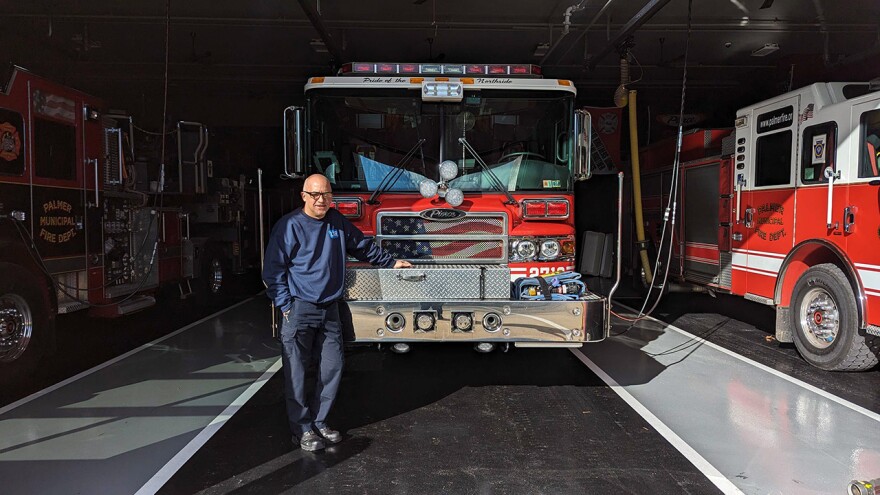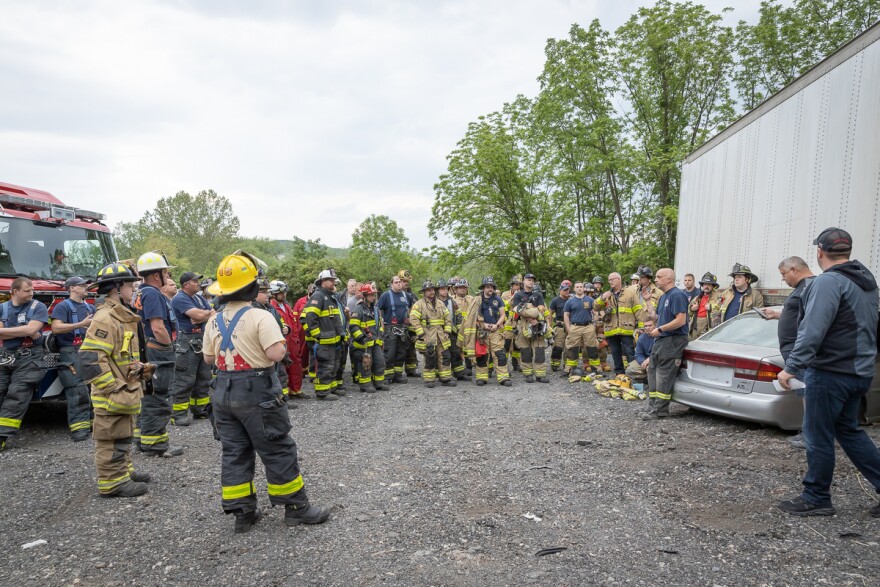PALMER TOWNSHIP, Pa. — Ken Sobieski never wants to find himself in a situation he’s ill-equipped to face.
But as deputy chief of Palmer Municipal Fire Department, Sobieski worries the fire service at large has fallen “behind the eight ball” in training with the latest tools and techniques necessary — not for fighting fires, but for vehicle rescue and patient-based extrication that can’t always wait on additional help being dispatched to a crash scene.
“We run more car accidents than anything at this point,” Sobieski said. “Monday [Dec. 18] we had five car accidents. That's all we did all day, from 6 o'clock in the morning until 9 or 10 at night, we had five different car accidents.”
It’s why Sobieski and others have come together to prepare for the types of emergencies they’re sure to encounter on our local roads — and to make sure others are prepared as well.
"Like, these buses and these trucks, they're big. Nobody really knows how to handle these kinds of scenarios when they do crash.Ken Sobieski, deputy chief of Palmer Municipal Fire Department
“This started prior to COVID," Sobieski said. "Actually, myself and a few other guys were taking a rescue class and a couple of us started talking.
"Like, these buses and these trucks, they're big. Nobody really knows how to handle these kinds of scenarios when they do crash.
“So we kind of said, maybe let's get a group of guys together and see if we can start experimenting and going through the training of bigger truck kind of accidents, you know, including school buses, transit buses, 18-wheelers, all that kind of stuff.”
‘Standing around is not an option'
Sobieski didn’t know it yet, but that conversation laid the foundation for what would become Lehigh Valley Rescue, now an officially recognized nonprofit with 501(c)(3) status.
The idea is to go beyond the basic level of training and use it as a base to build upon, preparing for days these first responders hope to never see.
“If one of these buses or tractor-trailers goes off the road, you know, 60 or 70 feet into the woods, that heavy wrecker is not going to be able to help you in some cases," Sobieski said.
"So now what? And who's coming to save you?”
"If one of these buses or tractor-trailers goes off the road, you know, 60 or 70 feet into the woods, that heavy wrecker is not going to be able to help you in some cases. So now what, and who's coming to save you?”Ken Sobieski, head of Lehigh Valley Rescue
More people than ever before are calling the fire department, Sobieski said, and those calls for service put a strain on volunteer departments throughout the region that can’t always get trucks out the door.
This year, Palmer Township firefighters topped 800 calls after totals of 700 to 750 for a number of years. Neighboring Bethlehem Township crested 1,000 calls for its department — its highest number on record.
“I would venture to guess that’s a lot of car accidents in there,” Sobieski said, detailing a few recent experiences that helped to reshape his approach to accident calls.
“A few years ago, we had one out on Route 33, a woman going south went sideways into a tree. And they call it intrusion when your door kind of goes in where it's not supposed to go in.
"She had a significant amount of intrusion on the passenger door and it took us probably a good hour to get her out of there.
“A year ago, we had a kid going west on Route 22 just past 25th Street. He hit a guardrail, right on his passenger side door. He was going fast enough that the guardrail actually did what it was supposed to do and coiled up.
"He had 18 feet of guardrail on top of him and in the car. That was tricky, but we came and did what we were supposed to do and got him out.”
Those stories showcase a depth to rescue training and tactics — especially when it comes to stabilizing accident scenes to keep rescuers safe and to safely rescue victims.
To Sobieski, it doesn’t involve standing around waiting for others to jump in.
“There's a lot of departments that are going to approach it as, ‘Oh, we have a vehicle that is under a tractor-trailer, and I'm just going to call for one of our heavy wreckers and they're going to help me.’
“My perspective is, that's not good enough,” Sobieski said. "We get there, but by the time they get there it could be 20 or 30 minutes. That's 20 or 30 minutes that we could be doing something to try and help the patient in that vehicle or patients in that vehicle.
"My perspective is that standing around is not an option.”
‘We’re trying to build something’

Back in spring, Lehigh Valley Rescue went from idea to reality when more than 100 first responders showed up to learn valuable skills at a first-ever training event.
It featured different stations and scenarios designed to replicate hazards Sobieski knows he’ll see again on Lehigh Valley roadways.
Two more events followed over the summer and into the fall, and there’s hope for four to six events in 2024 centered around vehicle extrication.
“You see what’s going on in the Lehigh Valley with warehouses. The warehouses are one thing, but the amount of truck traffic that it’s putting on our roads is incredible. And I can tell you that within Northampton County specifically, there’s probably two or three departments that can handle something of that magnitude if they do crash, or whatever the case may be.”Ken Sobieski, deputy chief of Palmer Municipal Fire Department
“You see what’s going on in the Lehigh Valley with warehouses,” Sobieski said. “The warehouses are one thing, but the amount of truck traffic that it’s putting on our roads is incredible.
"And I can tell you that within Northampton County specifically, there’s probably two or three departments that can handle something of that magnitude if they do crash, or whatever the case may be.”
To carry forward and keep costs to a minimum, Sobieski knows there’s work to do.
“Lehigh Valley Rescue is a separate entity" not connected to any municipal fire service, he said. “The biggest concern I have at the moment is insurance.
"It's a new organization and obviously some of this stuff that we're dealing with includes high-powered hydraulics, cutting glass, etc. So my next goal is to figure out insurance and how to pay for it.
“We’re going to continue to focus on extrication, and we're gonna continue to try and do it at zero cost. We may do some classes and ask for donations, but it's just to cover our expenses.”
In reflecting on 2023 and looking to the future, Sobieski was also quick to credit “the people showing up, the faces, the conversations” that have led to this point — including names like Ray Henry, Josh Smith and the late John Kalynych.
“John was a huge, huge part of moving us forward,” Sobieski said. “John threw out this idea, ‘Let’s put a Facebook page out there and just open it up and see who’s interested.'
“Now, if I can get guys out of their houses another night during the week, and I can give them something that they can use on the streets, either that night, the next day or a year from now, I’m going to do it.
“They're learning what their neighbors have on their trucks, they're meeting new people, and the camaraderie is incredible. Knock on wood, the feedback for us has been great and is continuing to drive us to do this.”
















